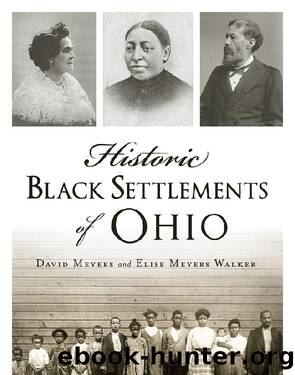Historic Black Settlements of Ohio by David Meyers

Author:David Meyers
Language: eng
Format: epub
Publisher: Arcadia Publishing Inc.
Published: 2020-01-15T00:00:00+00:00
NEWLIN COLONY (RUSHCREEK TOWNSHIP)
John Newlin became a slave owner for the express purpose of freeing them. A âmerchant, industrialist, land speculator, abolitionist, and Quaker leader, [John] was born in the southeastern part of present-day Alamance County [North Carolina].â249 He used only hired workers in his many successful enterprises and was an outspoken opponent of slavery. John was also an active member of the Manumission Society of North Carolina, assisting slave owners in liberating their slaves. Usually, this involved a lot of legal wrangling because of North Carolinaâs laws governing such matters.
When her first husband died, Sarah Foust Freeman inherited twenty-five to forty slaves. Although they had discussed freeing them, her late husband had never gotten around to doing so. Before she entered into a second marriage, âshe and her prospective husband signed an agreement that left her in complete control of her slaves and other property.â250 After she remarried, Sarah revised her will to leave her slaves to John Newlin, having previously arranged with him to take them to a free state and give them their freedom.
However, when Sarah passed away in 1839, a number of would-be heirs stepped forward and filed a blizzard of lawsuits in an attempt to break the will and claim the slaves. Three of the lawsuits eventually made their way to the North Carolina Supreme Court, the last in 1851. During the ensuing twelve years, John had been prevented from acting upon Sarahâs wishes. He also, apparently, put the slaves to work in order to pay for their own upkeep, but there is no evidence that he personally profited from their labor.
Finally, the court ruled in Johnâs favor, and he was able to remove the slaves to Logan County where âfrom motives of benevolence and humanity have manumitted and set free from slavery and bonds of servitudeââfortytwo in all.251 Most went by the surname Newlin, but a few adopted Burnett, Carter and Nichols. The Newlins did not make a good impression. âThey were directly from a state of slavery,â the author of a county history wrote in 1880, âhaving been manumitted by their master by will. As a class, they were much inferior to the colored people hitherto in the country, being sadly addicted to the use of intoxicating drinks.â252
This rather harsh assessment is borne out by a series of newspaper articles chronicling their criminal behavior, which culminated in the lynching of Seymour Newlin. (It may have been a case of mistaken identity.)253 However, by 1900, there were Newlins in Rushcreek, Monroe, Perry and Brokencreek Townships in Logan County.
Download
This site does not store any files on its server. We only index and link to content provided by other sites. Please contact the content providers to delete copyright contents if any and email us, we'll remove relevant links or contents immediately.
Keeper of Genesis by Graham Hancock(1606)
Hieroglyphs: A Very Short Introduction by Penelope Wilson(1312)
The Road to Ubar by Nicholas Clapp(1149)
Rembrandt Drawings by Rembrandt(1087)
The John Green Collection by Green John(1014)
Catching Fire: How Cooking Made Us Human by Richard Wrangham(956)
Forbidden Archeology's Impact: How a Controversial New Book Shocked the Scientific Community and Became an Underground Classic by Michael A. Cremo(952)
A Short History of the World in 50 Failures by Ben Gazur(917)
Hidden History: Lost Civilizations, Secret Knowledge, and Ancient Mysteries by Brian Haughton(878)
Primitive Mythology by Joseph Campbell(851)
The Creation of Inequality: How Our Prehistoric Ancestors Set the Stage for Monarchy, Slavery, and Empire by Kent Flannery & Joyce Marcus(839)
Hidden History by Jim Willis(829)
The History of Atlantis by Lewis Spence(786)
Neolithic by Susan McCarter(772)
Dinosaurs by Norman David;(759)
Searching for the Messiah by Barrie Wilson(745)
The Ancient Giants Who Ruled America: The Missing Skeletons and the Great Smithsonian Cover-Up by Dewhurst Richard J(700)
Ancient History from Coins by Howgego Christopher;(700)
The Christians Who Became Jews by Christopher Stroup;(682)
